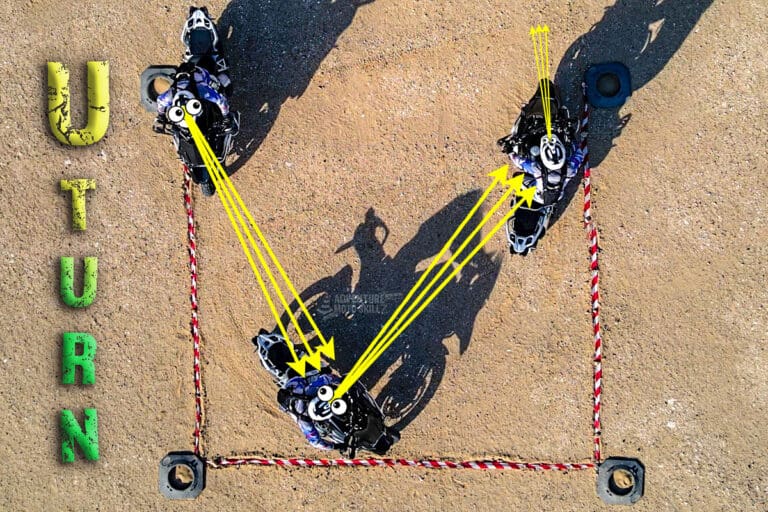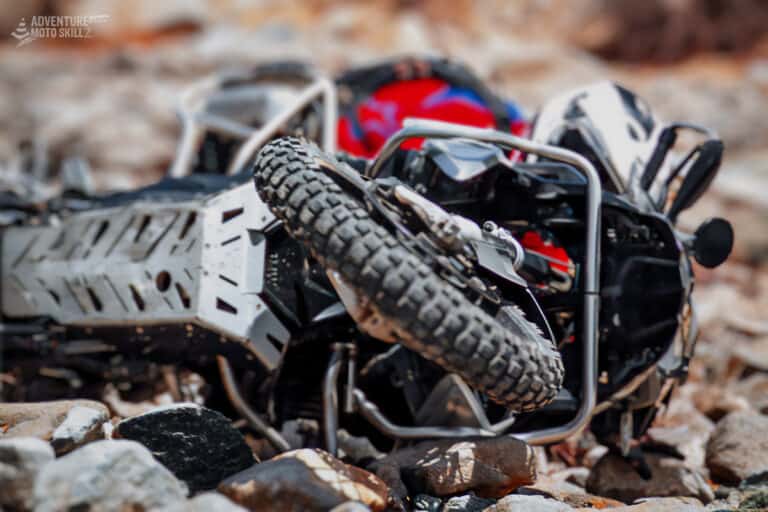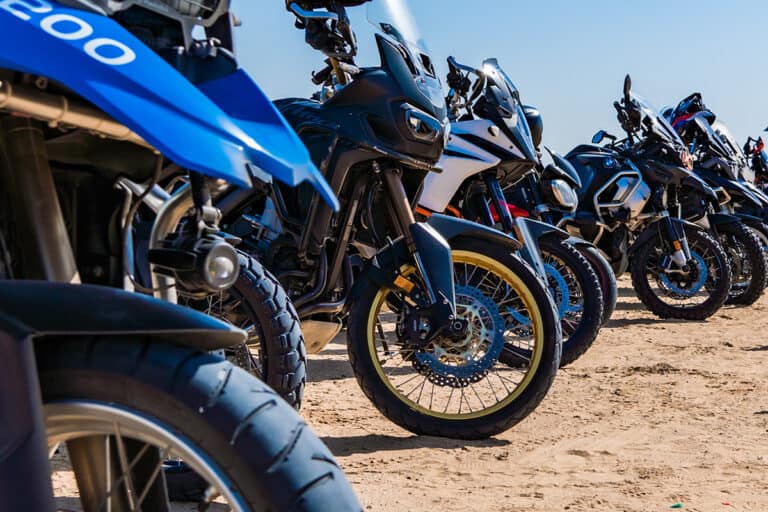All the Gear All the Time – ATGATT for Motorcycle Riders
ATGATT is the most important acronym in motorcycle riding. The All The Gear All The Time commitment means that if you are riding a bike, you wear full protective gear. What gear is included in this list? Let’s take a look.
ADVMotoSkillZ defines All The Gear All The Time as gear that protects:
- Head
- Spine
- Chest
- Shoulders
- Elbows
- Hands
- Hips
- Knees
- Ankles/Feet
- Neck (for certain riding styles)
This post may contain Affiliate Links. Please see our Privacy & Disclosure Policy for more details.

Every time I get on my bike I am wearing protective clothing from head to toe. So this post will explore the rider’s protective gear from my personal perspective. In reading about the essential pieces of kit, you will understand why I wear each item. It is my hope that these tidbits from my riding stories will inspire you to also commit to the ATGATT philosophy
PROTECT THE POINTY BITS … if any part of your body sticks out then it needs to be protected!
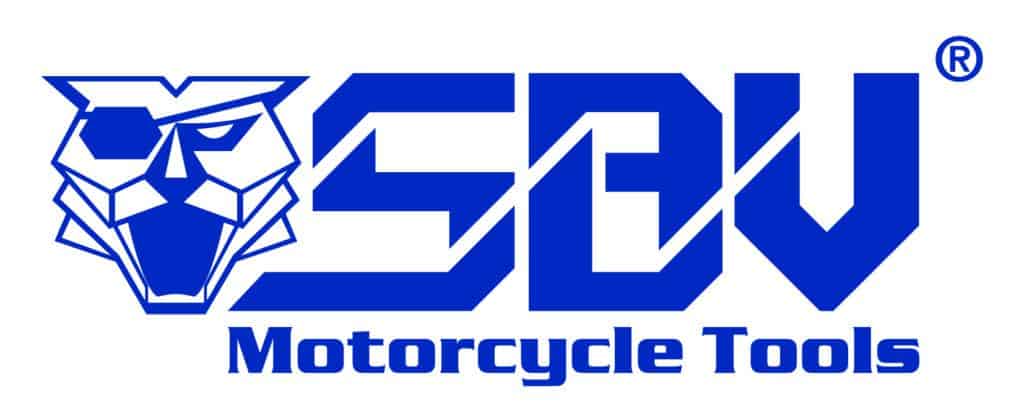
Innovative Motorcycle Tool Sets – Compact & Reliable
Used and recommended by ADVMotoSkillZ
Essential motorcycle rider gear for ATGATT goals
Helmet
This is the most obvious of all protective gear recommendations for motorcyclists. The three main categories of helmets are full face, open face, and half helmet.
Full-face helmets offer the most protection, as they cover your entire head and face. They’re great for racing or long-distance riding, as they provide a comfortable, aerodynamic fit. But, they can be hot and claustrophobic in stop-and-go traffic. Modular or flip-up helmets are a type of full-face helmet that be a good choice if your riding style involves a lot of stop and go.
Open-face helmets offer less protection than full-face helmets. But, they’re more comfortable in warm weather and easier to put on and take off. They do not provide as much aerodynamic protection or any eye protection, so they are not ideal for high-speed riding. Wearing some sort of goggles or glasses with open-face styles is recommended.
Half helmets offer the least amount of protection. Many riders claim they are the most comfortable because they don’t obstruct vision or hearing. In the event of a crash, this style of helmet will not be as effective as full or open-face helmets.
No matter which type of helmet you choose, always make sure it’s properly fitted and meets all safety standards. A poorly fitted helmet does not provide optimal protection so does not qualify for ATGATT status.

These days my riding includes off-road adventure and on-road commuting and touring.
For off-road riding, I look for a full-face helmet that is lightweight, with an external visor, and an internal sun shade. After finding those three features, comfort and proper fit are the deciding factors.
Why are these features important to me? Full face protection is critical for off-road riding because flying dust and debris are common at all times. Having protection around the chin protects the lower half of the face in the event of a fall. It is common for riders to stop short or land hard on a jump and hit their chin/face on the handlebars.
Heavy helmets get tiring on long rides or bumpy surfaces, lightweight just makes the ride more enjoyable. Sunlight and reflections create a visual hazard when riding. A good visor on a helmet reduces direct sun into my eyes, while the internal sun shade offers additional glare protection. The versatility of flipping the sun visor up and down allows me to use it as needed on the fly.
NOTE: Some off-road riders prefer an MX-style helmet (no face shield) paired with eye goggles. This is a solid choice, just not one I enjoy. The aerodynamic advantage and complete protection offered by the full-face model is for me.
For commuting and touring on-road, a modular helmet that has a flip-up visor is my preferred choice. It offers complete protection with the advantage of being able to quickly flip up the chin bar. This feature is great to get some air at stop lights or to easily talk without removing the helmet.
See more on my helmet choices here.
Jacket
A motorcycle riding jacket provides three main functions. First, it is a layer of protection in case of an accident or fall. Second, it insulates you from the elements (wind, water, etc). Lastly, it can make you more visible to other riders with bright colors or reflective tape.
Protective padding should be included with riding jackets in the areas most vulnerable to injury. Not all jackets will carry the same level of padding quality or have the same locations covered. Be sure to research before investing. As a minimum, ensure your jacket has protection for the spine, elbows, and shoulders. Many jackets also provide padding for the chest.
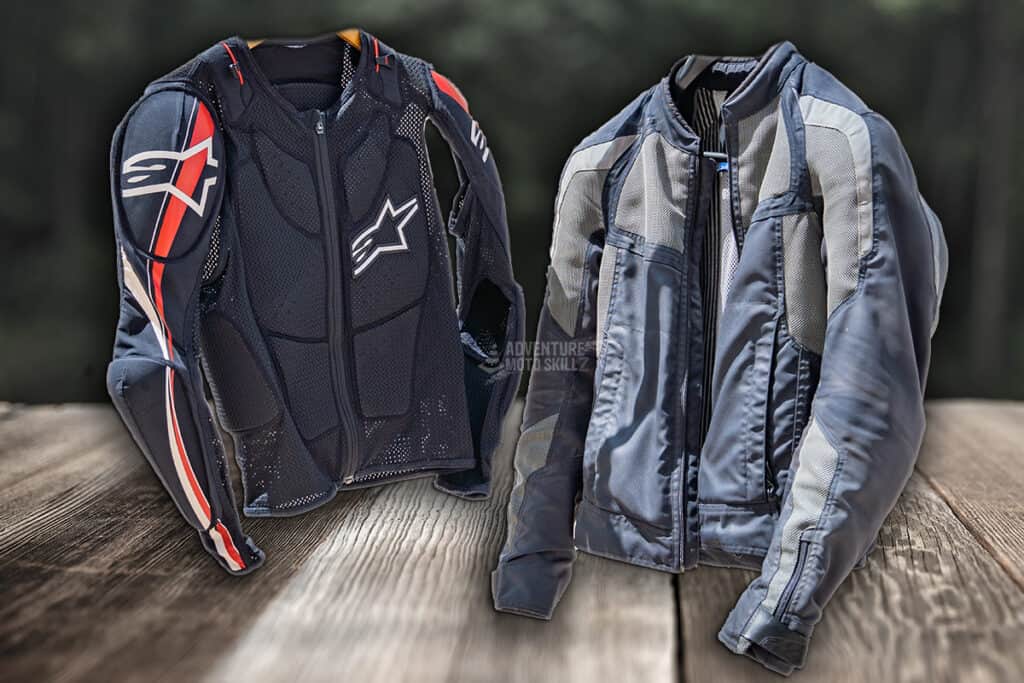
Just like with the helmets, I go for two different designs depending on the type of riding on my agenda.
For off-road adventure riding, I like a form-fitting armor jacket worn under a thin riding jersey. These provide full protection with maximum mobility and breathability. CE-rated padding should be located on the back, shoulders, elbow, and chest.
If you go with this MX-style upper body armor, remember to wear a bright-colored jersey for visibility. This setup may not offer the same level of abrasion resistance as a textile jacket, but I find that it always holds the protective padding in the right spots when I fall. Also, be willing to feel the wind and weather during your ride as this offers no wind or waterproofing.
For commuting and touring, a high-quality riding jacket appropriate for the weather works well. The flexibility to take the jacket off when the ride is over or for a coffee break is ideal.
See more on my jacket choices here.
Gloves
Motorcycle riding gloves protect your hands in case of a fall off the bike and from the weather. Protection, design, and fit are the priorities for a pair of gloves.
First look for gloves that provide padding where you need it for your riding style. Next look at design options, such as with/without cuff and material. Then try on all the gloves that have made the cut. If they do not feel comfortable in the store, don’t buy them.

For off-road adventure riding, I look for a moderate knuckle guard and good palm protection. Falling and tipping over are common during off-road riding, so a glove with a palm pad will save your hands. When off-road I also prefer full wrist movement so go for a short cuff model. A nice bonus feature is a touch screen index finger pad for GPS use without taking off the gloves.
I am quite happy to commute and tour with the same gloves most of the year. During the colder weather, a full cuff (gauntlet style) and weatherproofing do offer added comfort.
The only time I’ve gone down on the asphalt involved a darting goat directly in my line during cornering. The bike went into a low side slide onto the left. My right hand ended up slapping to ground in an attempt to break the fall as we slid across the road. Back then, my touring gloves did not have proper palm padding. My hand sustained a massive bruise and swelling from the fall due to a lack of palm protection. Fortunately, the leather did protect me from road rash or cuts. All of my gloves have a thick palm pad now!
See more on my gloves choice here.

Top-quality gear for your next adventure
Used and recommended by ADVMotoSkillZ
Pants/Trousers
When it comes to protecting hips, legs, and knees while riding, we are spoiled for choice in today’s market. Many trousers have padding built in while others can be worn over form-fitted padding. But first, let’s discuss fabric:
Leather motorcycle riding pants are the most traditional type of riding pants. They are durable and offer excellent protection against abrasion in the event of a fall. However, leather motorcycle riding pants can be very hot and uncomfortable to wear in warm weather. They are difficult to weatherproof making them a poor choice in rain.
Synthetic motorcycle riding pants are made from a variety of different synthetic materials. These fabrics provide better breathability, flexibility, and weather resistance versus leather. These fabrics still do not beat out leather’s abrasion resistance but can be paired with quality padding.
Kevlar and Aramid linings can be found on motorcycle riding jeans and similar. These synthetic fibers are very light, heat/abrasion resistant, and comfortable to wear. This lining provides a nice compromise between fashion and safety for casual on-road riders.
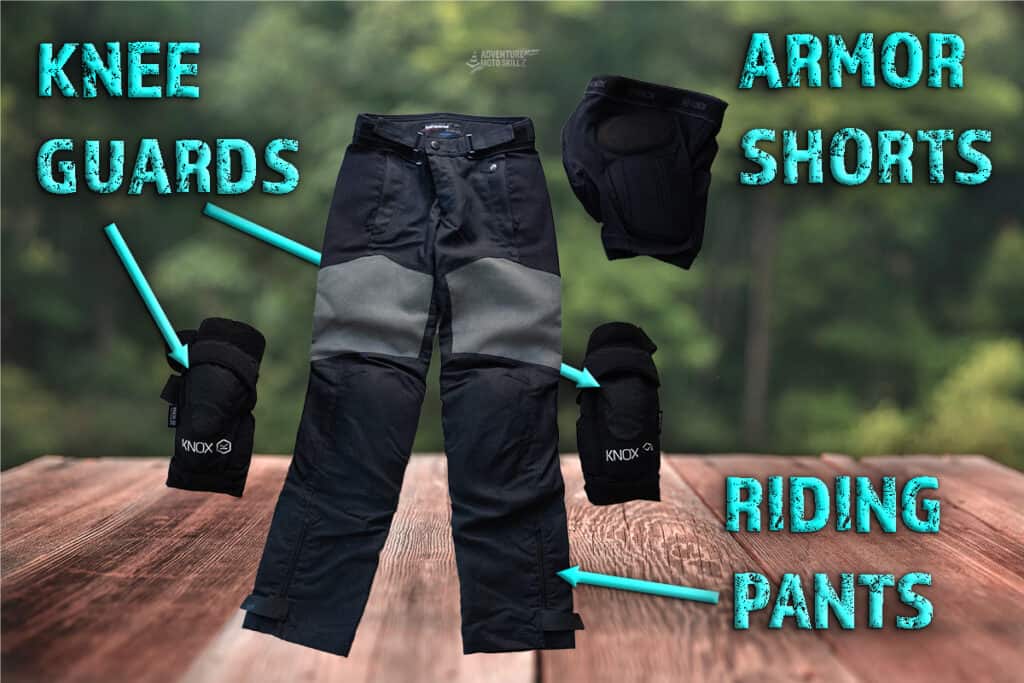
For off-road adventure riding, I like to know my hips and knee pads are exactly where they should be at all times. Form-fitted padded shorts and knee guards worn under mesh riding pants are my choice. The padding never moves from its position and I am free to move my body as needed for the ride.
For touring and commuting, a comfortable pair of riding trousers with padding does the job. By investing in matching jackets and pants you will look great and gain convenient zip-together features.
See more on my off-road padded shorts, knee guards, and on-road tourer trousers here.
Boots
Motorcycle boots have several key features that provide safety and comfort, such as:
- reinforced toe area to protect your feet from being crushed in an accident
- padded ankle area to prevent injuries from motorcycle vibrations
- textured sole to provide traction and grip while riding
- tall shaft to protect your legs from being scraped by the motorcycle
- wide calf area to provide support and comfort while riding.
Motorcycle boots should be comfortable enough to wear all day while providing good support and traction while riding. Motorcycle boot uppers are usually made from leather or other synthetic materials. Kevlar may also be used in the form of a protective lining.
Your riding style will demand specific features from your boots, so it is important to seek out brands that cater to your style.

For off-road riding, I have two different boot styles that I choose from based on the terrain of the ride.
For gravel, sand, and single-track riding, I wear boots with a tall leather-synthetic upper and durable rubber sole. The height helps protect my shins and is great for any surprise water crossings. The leather-synthetic upper allows for the flexibility needed in the ankles for sand and gravel.
If I am planning for lots of big rocky terrain, then a hard enduro-style boot gives me peace of mind. These hard boots will provide the maximum amount of protection for an ankle trapped between a heavy motorcycle and a rock.
For commuting, a lower-cut riding boot can be a comfortable alternative to the weight of off-road boots. But for long touring, I am happy to accept the weight of the off-road boot for the extra protection they offer.
See more on my off-road leather-synthetic boots and enduro boots here.
Honorable mentions
Neck gaiters are a great item to carry with you. They can be worn on the neck to deflect wind and weather or save you from a sunburn. They can also be worn on the head to protect your hair from the helmet and add a layer of warmth. Get your ADVMotoSkillZ branded neck gaiter here.
Neck braces reduce neck and collar bone injuries during crashes. Although more commonly worn by MX and enduro riders, these can be adapted to any riding style.
Hydration packs should be worn by all off-road riders to protect from dehydration. The physical demands of riding coupled with extreme weather conditions will dehydrate a rider quickly. Being able to sip throughout the day without stopping the bike minimizes this risk. My hydration pack choice can be found here.
And don’t forget your ADVMotoSkillZ t-shirt or hoodie for after-ride relaxation!
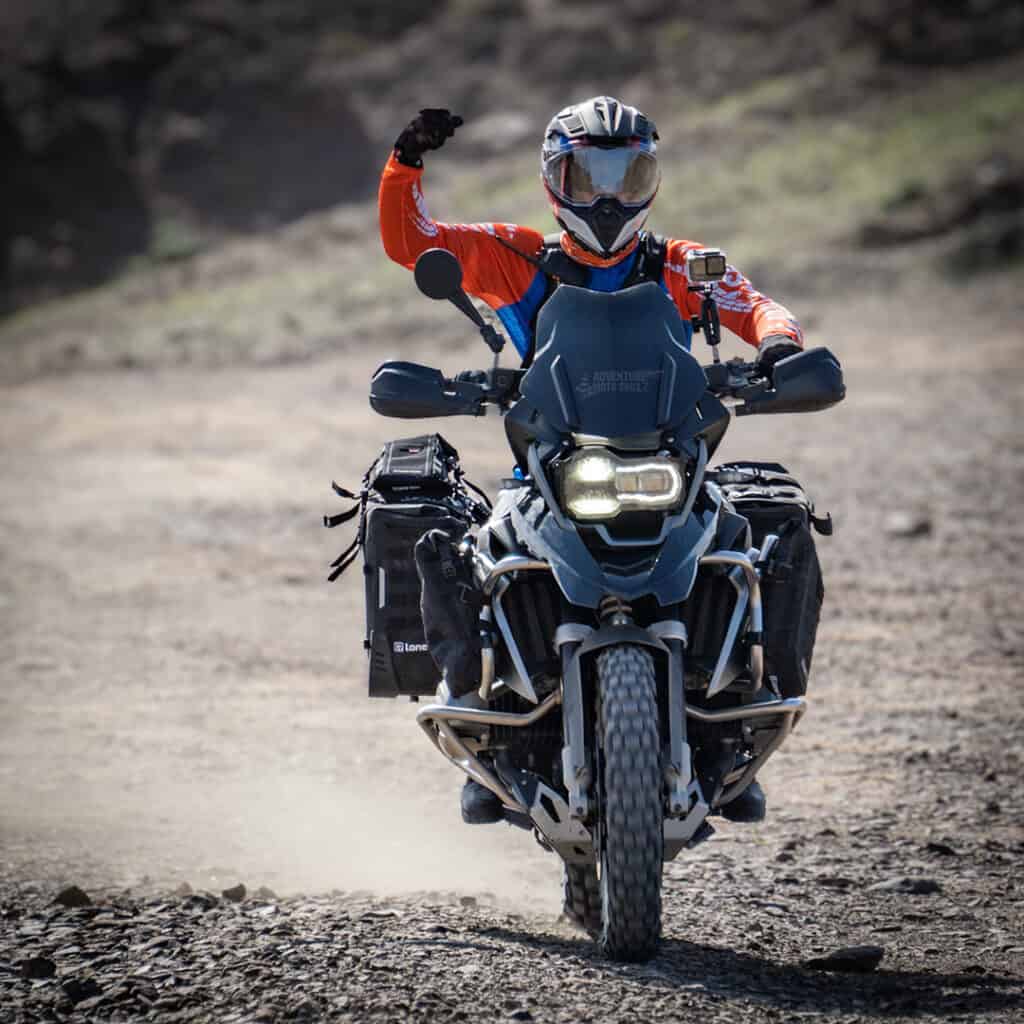
About the Author
Coach Mike is a Certified Off-Road Motorcycle Instructor & founder of ADVMotoSkillZ.
Riding tips from ADVMotoSkillZ reach thousands of international riders daily through social & blogs.
Click here to learn more about Mike’s motorcycle evolution from a Harley road rider to finding his true passion for off-road riding on a BMW 1200 GS.
If you would like to send Mike a quick message or invite him to provide training at your local facility, then visit the contact page here.



